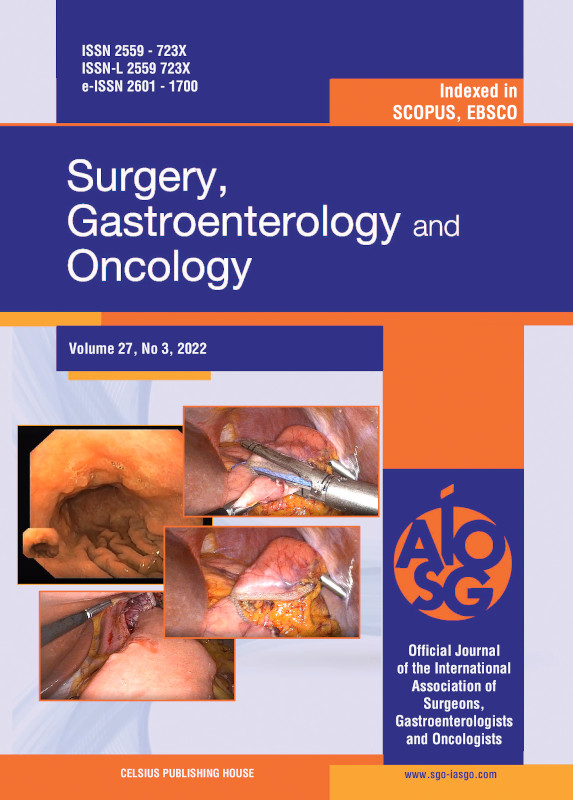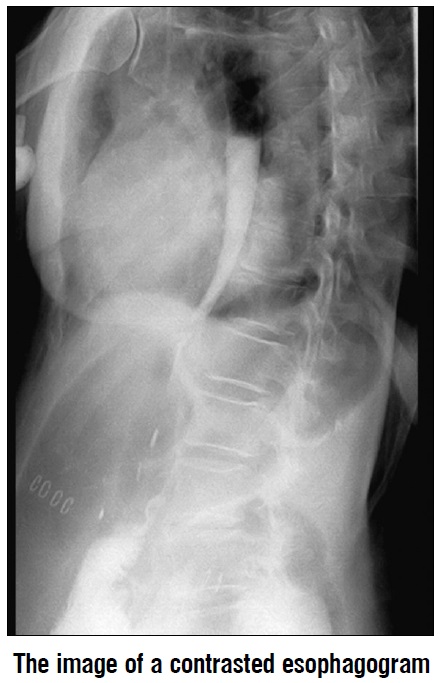Surgery, Gastroenterology and Oncology

|
|
Introduction: Several interposition techniques have been described for reconstruction after total gastrectomy in FAP patients, in open (1) and laparoscopic assisted surgery (2,3,4). The Longmire technique has the advantage of allowing all the food to pass through the duodenum and better absorption of nutrients, such as iron (5). Here, we describe the use of a pedicled isoperistaltic jejunal flap interposition technique to reconstruct the digestive tract after total gastrectomy, fully performed by laparoscopic approach, in a patient with FAP that had previous total colectomy. Our patient was a 68-year-old woman, with “MUTYH-Associated Polyposis (MAP)”, a c.494A>G mutation at exon 7 and c.1145G>A mutation at exon 13. She was diagnosed with gastric cancer and lesions of high- and low-grade dysplasia. She was previously submitted to a laparoscopic total colectomy, 2009, and a conservative breast surgery plus chemoradiotherapy in 2017. She also had duodenal and rectum polyps in her surveillance exam.

Surgical technique: Five access ports were used. We performed a standard total gastrectomy with D2 lymphadenectomy. The reconstructive phase of the surgery started with the selection of a jejunal loop, 50 cm after the Treitz ligament, which was sectioned, in order to enable an oesophagojejunal anastomosis. The jejunal loop was connected to the duodenum through a side-to-side anastomosis with a linear endo stapler. This created an isoperistaltic conduit with the required extension for a tension-free anastomosis. Afterwards, the jejunal loop was sectioned immediately distally to the jejunoduodenal anastomosis and digestive continuity was restored with a side-to-side jejunojejunal anastomosis. Operative time was 4 hours and 7 minutes. Blood loss was less than 150 mL. No intraoperative or postoperative complications occurred. The patient was discharged on the seventh post-operative day. She has been on follow-up as an outpatient for seven months, without any relevant symptoms.
Conclusion: We hereby describe a technique that has been previously used by others with good results, but with the novel contribution of performing the surgery entirely by laparoscopy.
Author's contribution
José Barbosa: Conceptualization, Writing - Original Draft, Writing - Review & Editing, Visualization. Fabiana Sousa: Methodology, Software. Manuela Batista, José Pedro Barbosa: Writing - Review & Editing. Elisabete Barbosa: Writing - Review & Editing.
Declarations of interest: none.
Ethical approval
For this case ethical approved was obtained.
REFERENCES
1. Zuin M, Celotto F, Pucciarelli S, Urso EDL. Isoperistaltic jejunal loop interposition after total gastrectomy for gastric cancer in patients with familial adenomatous polyposis. J Gastric Cancer. 2020;20(2):225-231.
2. Omori T, Nakajima K, Endo S, Takahashi T, Hasegawa J, Nishida T. Laparoscopically assisted total gastrectomy with jejunal pouch interposition. Surg Endosc. 2006;20(9):1497-500.
3. Otsuka R, Hayashi H, Hanari N, Gunji H, Hayano K, Kano M, et al. Laparoscopic double-tract reconstruction after total gastrectomy for postoperative duodenal surveillance: Case series. Ann Med Surg (Lond) 2017;21:105-108.
4. Hong J, Qian L, Wang YP, Wang J, Hua LC, Hao HK. A novel method of delta-shaped intracorporeal double-tract reconstruction in totally laparoscopic proximal gastrectomy. Surg Endosc. 2016; 30(6):2396-403.
5. Longmire WP, Beal JM. Construction of a substitute gastric reservoir following total gastrectomy. Ann Surg. 1952;135(5):637-45.
Full Text Sources:
Abstract:
Views: 2035

For Authors
Journal Subscriptions

Jun 2025
Supplements
Instructions for authors
Online submission
Contact
e-ISSN: 2601 - 1700 (online)
ISSN-L: 2559 - 723X
Journal Abbreviation: Surg. Gastroenterol. Oncol.
Surgery, Gastroenterology and Oncology (SGO) is indexed in:
- SCOPUS
- EBSCO
- DOI/Crossref
- Google Scholar
- SCImago
- Harvard Library
- Open Academic Journals Index (OAJI)
Surgery, Gastroenterology and Oncology (SGO) is an open-access, peer-reviewed online journal published by Celsius Publishing House. The journal allows readers to read, download, copy, distribute, print, search, or link to the full text of its articles.
Time to first editorial decision: 25 days
Rejection rate: 61%
CiteScore: 0.2

Meetings and Courses in 2025
Meetings and Courses in 2024
Meetings and Courses in 2023
Meetings and Courses in 2022
Meetings and Courses in 2021
Meetings and Courses in 2020
Meetings and Courses in 2019
Verona expert meeting 2019

Surgery, Gastroenterology and Oncology applies the Creative Commons Attribution Non Commercial (CC BY-NC 4.0) license, which permits readers to copy and redistribute the material in any medium or format, remix, adapt, build upon the published works non-commercially, and license the derivative works on different terms, provided the original material is properly cited and the use is non-commercial. Please see: https://creativecommons.org/licenses/by-nc/4.0/
Publisher’s Note:
The opinions, statements, and data contained in article are solely those of the authors and not of Surgery, Gastroenterology and Oncology journal or the editors. Publisher and the editors disclaim responsibility for any damage resulting from any ideas, instructions, methods, or products referred to in the content.
 IASGO Society News
IASGO Society News